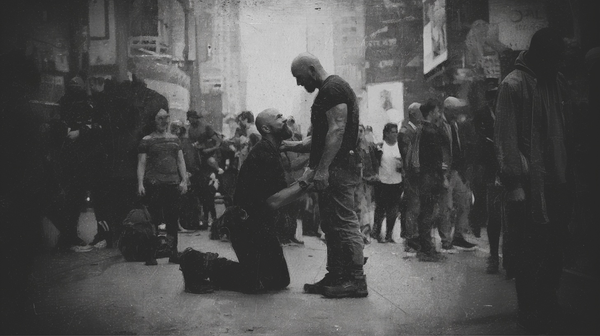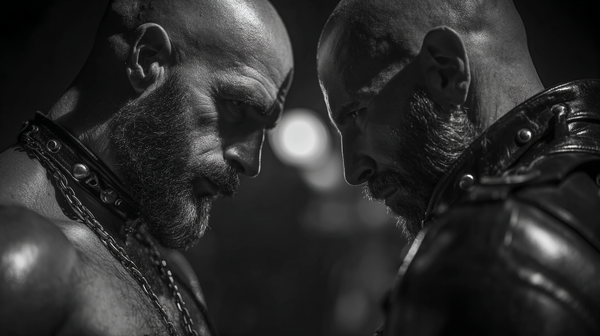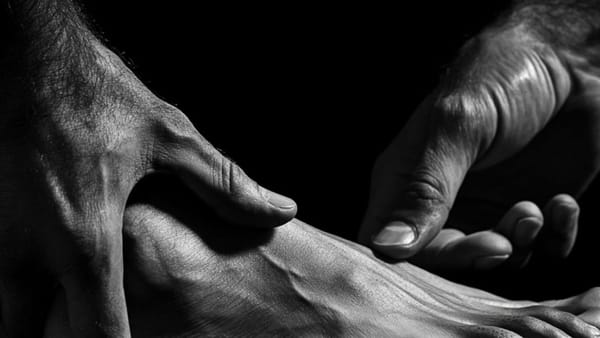The Purpose of Pain
Punishment and pain in BDSM are purposeful tools to correct, reinforce rules, deepen submission, and unleash the slave’s primal instincts. It must be tailored, meaningful, and integrated into sessions. Paired with aftercare, it builds trust, strengthens bonds, and shapes the Master-slave dynamic.

Physical punishment is my favorite aspect of BDSM, the one that resonates more deeply with my instincts as a Master. The touch and weight of a leather whip in my hand, the intoxicating scent of fear lingering in the air, the silent anticipation in my slave’s eyes as he braces for the next strike—all ignite a visceral thrill. The sharp crack of the whip against skin, the surge of adrenaline coursing through both of us, and the lasting marks etched into his flesh—each moment is a symphony of dominance, pain, and submission.
But it’s more than sensory indulgence. Punishment is, in my opinion, an essential tool for forging the D/s dynamic. Every stroke carries meaning, solidifying the power exchange and reminding the slave of his place. It’s not just an act of discipline—it’s the language of control, spoken through flesh and blood.
Beyond Arbitrary Pain
Punishment is not about mindlessly hitting, flogging, or whipping a slave. It is a deliberate act with meaning, intention, and purpose. Like a craftsman shaping raw material, a Master uses discipline to mold his slave, reinforcing lessons, correcting behavior, and deepening submission. Each strike, each command, should be imbued with significance, aimed not at mere pain but at progress.
Without context, pain risks becoming hollow or even damaging. It loses the trust and respect that a slave offers his Master and reduces the exchange to something shallow and mechanical. But when punishment is purposeful—when it aligns with the Master’s vision for his slave’s growth—it transforms into something far greater. It becomes an act of connection, a testament to the bond between Master and slave.
Uses of Pain
Correction
Pain is a Master’s way of addressing disobedience, mistakes, or any behavior that falls outside the established rules. It is not about anger or retribution but about realignment. When a slave errs, punishment serves as a reset button, reminding him of his place and responsibilities.
Reinforcement of Rules and Structure
Discipline reinforces the framework of the D/s dynamic. Every lash, strike, or command is a tangible reminder of the power exchange that defines the relationship. Rules are not suggestions; they are the foundation of submission, and pain underscores their importance.
Deepening Submission
Beyond correction and reinforcement, pain is a tool to deepen the slave’s psychological surrender. The act of accepting pain at the hands of his Master requires trust and devotion. With each punishment, the slave learns to let go of control, embracing his role and offering himself fully. This surrender strengthens the bond between us and our slaves.
And the most important one...
Awakening the Animal
Perhaps the most profound purpose of pain is unleashing the primal, animalistic core of the slave. By pushing him to his physical limits, punishment forces the slave to endure and surpass his rational mind. As pain crescendos, logic and reason recede, and the animal emerges—raw, instinctual, and ready to serve. When the punishment ends, the animal remains, stripped of pretense, concerns, prejudices, and woes, and fully receptive to his Master’s will. In this state, the slave is perfectly positioned for reprogramming, reshaping his mind and deepening the Master’s control. It is here, in this primal space, that the true transformation begins.
No two slaves unleash their animal in the same way. For some, it’s a primal growl; for others, a desperate attempt to bite or even lash out in defiance. The animal manifests differently—some fight, some submit entirely, and others oscillate between resistance and surrender.
The Session and Beyond
Before punishment can be effective, a Master must understand his slave. What are his physical and psychological thresholds? What are his fears, triggers, and boundaries? A well-crafted punishment takes these into account—not to avoid them but to use them. Pushing a slave to his limits without crossing them is key to ensuring that punishment is challenging but not harmful.
Stay observant and attentive to your slave throughout the session, and don’t hesitate to check in on how they’re handling the pain. Especially in the early stages of a D/s relationship, I often ask my slaves to rate the intensity of the pain on a scale from 1 to 10. When the number approaches 10, I know I’m pushing their limits and must deliver the next strikes with precision and care.
Punishment and pain are not just for the moment—they are tools for shaping the slave’s behavior and mindset over time, and should be aligned with the Master’s long-term goals for his slave.
For example, if a slave struggles with maintaining posture (kneeling, on all fours, etc...), corporal punishment during a posture-focused session can reinforce the importance of his training. When punishment is tied to training, it becomes more than pain—it becomes a lesson.
Pain, Reward, and Aftercare
The balance of punishment and reward is essential for keeping the slave engaged and motivated. A slave who endures punishment should also feel the satisfaction of pleasing his Master, knowing that his obedience is valued.
Punishment, even when consensual and purposeful, can be intense—physically, emotionally, and psychologically. Aftercare is the moment when the Master tends to the slave, ensuring that he is physically safe, emotionally secure, and mentally balanced. It is not a weakness for us to offer care; it is a mark of strength and responsibility.
During aftercare, the Master acknowledges the intensity of what has transpired. The slave may need soothing words, a gentle touch, or time to process his emotions. Aftercare also reminds the slave that he is valued—not just as a vessel for punishment but as a person who willingly submits and trusts his Master.
Finally, the Master must maintain perspective. While the slave surrenders control, it is the Master who must guard the balance. Pushing a slave too far, too fast, or neglecting his emotional needs can erode trust and harm the dynamic. A responsible Master ensures that every act of dominance strengthens the relationship rather than jeopardizes it.
Ultimately, punishment is as much about the Master as it is about the slave. A good Master commands the space, his every action deliberate and precise. The way he delivers punishment—his tone, his demeanor, his control—speaks volumes. A confident Master doesn’t need to shout or rage; his authority is evident in the calm, measured way he wields discipline.




